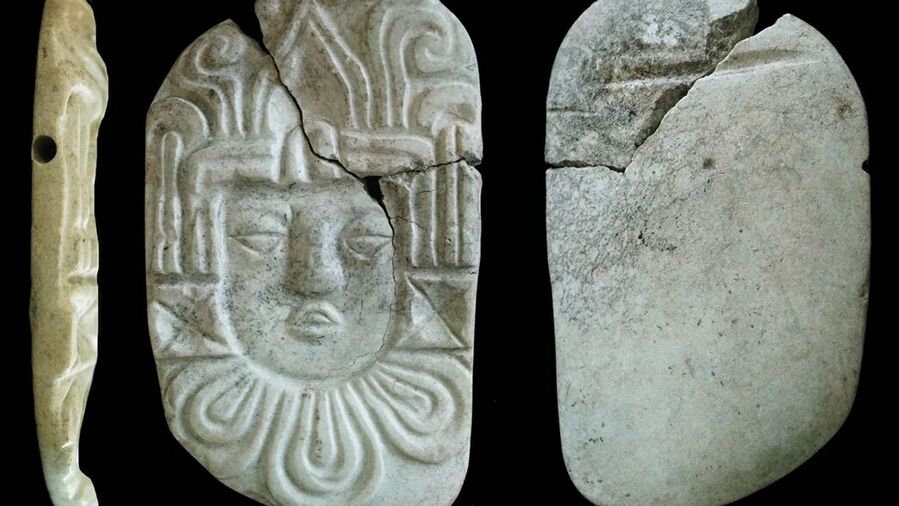
© C. Halperin/Courtesy AntiquityBurned grave goods found in a Maya pyramid with the royal bones included a carved pendant plaque of a human head.
The bones offer a rare glimpse of intentional corpse destruction in Maya culture to commemorate dramatic political change.
All of the remains belonged to adults, and scientists identified three of the individuals as male. Two were between 21 and 35 years old, and one was between 40 and 60 years old, researchers reported Thursday in the journal Antiquity. Among the bones were thousands of burned objects — whole and in pieces — including body adornments made of greenstone (green minerals, including jade), pendants made from mammal teeth, shell beads, mosaics and weapons. Their richness and abundance hinted at the royal status of the people in the tomb.
But the burning of artifacts and remains was unusual for royalty, as was their placement in this pyramid chamber. The revelation shed light on the rise of a new type of leader who likely redefined power during a time of societal transformation, the study authors said.
Ritual desecration of bones and royal trappings
Scientists found the burned bones and grave goods in 2022 at the bottom of a room underneath a temple, under a jumble of construction material. The burial lay beneath about 5 feet (1.5 meters) of large stone blocks typically used for facade construction — an unexpected arrangement for people of royal descent, said lead study author Dr. Christina T. Halperin, an associate professor of a nthropology at the University of Montréal.
Typically, Maya societies kept royal remains in accessible spaces where visitors could perform offerings. By comparison, this chamber "doesn't have all the telltale signs of what you would normally have for a royal burial," Halperin said. "They just dumped it in this one spot. And then they threw all of the construction fill right on top of it."
Shrinkage and warping in the charred, broken bones suggested that they were burned in a massive inferno at a temperature of more than 1,472 degrees Fahrenheit (800 degrees Celsius). Radiocarbon dating — analyzing decay rates of carbon isotopes to determine an object's age — showed that the burning happened around 773 to 881. However, the analysis also revealed that the people had died decades earlier; possibly as much as a century before their skeletons were burned, suggesting that the fire was linked to events that unfolded long after their deaths, the scientists wrote.
"This is a fascinating deposit of burnt human remains and precious objects clearly linked to royalty," Dr. Stephen Houston, a professor of anthropology and the history of art and architecture at Brown University in Providence, Rhode Island, told CNN in an email.
"Halperin is one of our most gifted field workers," said Houston, who studies ancient Maya culture but was not involved in the research. "This article exemplifies how we should interpret unusual remains," he added.
Fire illuminated a 'foreign' leader's rise
Researchers discovered the remains in a site called Ucanal, located about 249 miles (400 kilometers) north of Guatemala City. The ancient metropolis was the capital of the Maya's K'anwitznal kingdom, and during Ucanal's peak, from roughly 630 to 1000, city settlements covered about 10 square miles (26 square kilometers).
Around the start of the ninth century when the remains were burned, carved Maya records described the deeds of a new ruler called Papmalil. The name did not appear in earlier carvings, "and may have been foreign in origin," tracing its roots to Maya peoples from another region, according to the study.
Unlike the royalty who preceded him, Papmalil's official title — "ochk'in kaloomte," or "western overlord" — was associated with military leaders, Halperin said. Key changes in political alliances, the dismantling of old, elite monuments and the creation of new public buildings also marked this historic period. A ceremonial burning of prior rulers' bones may have highlighted the shift in leadership, the researchers reported.
Ritual desecration of royal remains by fire wasn't unknown in Maya culture. The Maya even had a term for it: "och-i k'ak' t-u-muk-il, 'the fire entered his/her tomb,'" the researchers wrote. However, there were no scorch marks in the chamber where the bones and artifacts were found, suggesting that the burning happened elsewhere.
"It could have been burned in their original tomb itself; it could have been burned in a public plaza space," Halperin said. But wherever the remains were scorched, a blaze of that scale wouldn't have gone unnoticed.
"It was such an extraordinary burning that it had to have been known by the public at large," she said. After the fire, the placement of blackened remains in the large temple-pyramid would probably have been part of other ceremonies commemorating Papmalil's ascension to power.
Evolving Maya society
Finding ancient Maya evidence that references transformative social change "is really exciting," Halperin said.
"We know so little about the politics that are happening during this time, and so it's an important event that helps us recognize a political transition. It really emphasizes that yes, political dynasties collapsed. But there's also renewal and a reworking of a society in different areas of the Maya world."
This enigmatic collection of burned bones and royal artifacts, dumped in a chamber and covered by building fill, "is nicely clarified by ritual links to practices known from Maya hieroglyphs and to the advent of an exalted if foreign person in historical records," Houston said. "Broader excavation at Ucanal may reveal other ripples in this shift of dynasties, perhaps in the form of torched buildings or rapid changes in artifacts."
The discovery also delivers insights into the persistence and continuity of Maya culture, Halperin added.
"It helps underscore the fact that Maya societies didn't end when their political systems changed," she said.
Source link

